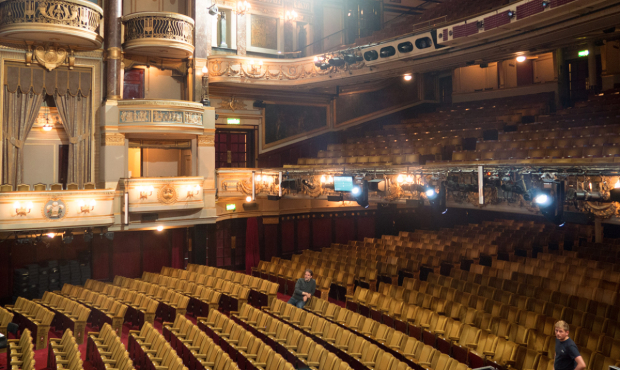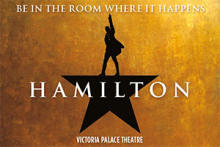Why are big theatres getting harder to fill?
Matt Trueman confronts the realities of some of the West End’s biggest venues as well as their biggest challenges

© Andrew DuPont
London theatre’s been booming for years, but record attendances and record receipts mask an interesting issue – namely, what do we do with the capital’s biggest theatres?
London has a number of cavernous spaces, but the fact is they’re getting harder and harder to fill. London has just two large-scale long-runners: Wicked at the Apollo Victoria (2,304 seats) and The Lion King at the Lyceum (2,100). The Palladium, once the home of popular entertainment, has struggled to find a stable tenant for years – ever since I Can’t Sing shut within seven weeks, losing £4 million in the process. Since then, a string of short runs and one-off gigs have filled the 2,236 seater. The Dominion (2,136) has churned through short-term shows since We Will Rock You set sail. Its current tenant, An American in Paris, lasted less than a year. Drury Lane’s (2,200) fared slightly better with Charlie and the Chocolate Factory and Shrek.
Making shows at this scale is a huge financial risk. As I Can’t Sing suggests, they put big bucks on the line and, while the rewards can be eye-watering, received wisdom these days is that slow and steady success in a smaller space is the more sensible option. The catastrophe of Spider-Man: Turn off the Dark, which racked up reported losses upwards of $60 million, was a cautionary tale for commercial producers everywhere. Big theatres are a hard sell right now.
Who’re making the shows that might survive at this scale?
Yesterday’s news that Drury Lane is to reduce its capacity is telling. Its owners, Andrew Lloyd Webber‘s Really Useful Group, have sought planning permission for a refurbishment that would drop its auditorium by 200 seats at a reported cost of around £35 million. That’s a lot of money to spend on reducing your box office potential, but doing so presumably makes the theatre a safer bet for producers. The addition of a restaurant next door, a way of shoring up income, points to the fact that big theatres are reassessing their financial models.
One of the reasons the English National Opera has gotten into such trouble over recent years is the size of its home venue, the Coliseum – a sweeping and grand Frank Matcham theatre that seats 2,359, making it the largest theatre in London. It’s not the ENO’s work that’s at issue, they stage some spectacular stuff, but even that can struggle to shift enough tickets over a handful of dates. Its recent turn to more populist fare to make up the shortfall – musical theatre, mostly – illustrates the issue. Even a grand spectacular, iconic jukebox musical like Bat Out Of Hell only ran for a couple of months. Granted, it’s coming back next year as a sell-out show, but could it have survived an open run on its own? I’m not so sure.
Is it possible that the supersized stage show has had its day?
The big question is this: Who’s making the shows that might survive at this scale? Look around and there’s not a lot that could fill the gaps. Frozen, currently playing try-outs in Denver, could well fill a gap, and it’s possible that the National has its eye on the prize with its forthcoming Pinocchio. I questioned the partnering with Disney when the project was first announced, but if commercial producers aren’t shouldering the risk at this level, there is at least a case for the subsidised sector providing support. King Kong‘s hovering on the horizon, if Jack Thorne and Drew McOnie can pull it into shape. Beyond that, there’s not much. Is it possible that the supersized stage show has had its day?
London’s most prominent new musicals – Matilda, School of Rock, The Book of Mormon, Kinky Boots – all of them are playing in venues between 1000 and 1500 seats. Hamilton‘s heading to a similar-sized space. Even Harry Potter and the Cursed Child, as close to a surefire smash-hit as you’ll ever see, opted to make the 1,397-seat Palace Theatre its London home. It might be moving into the second-biggest Broadway theatre, the Lyric, but the auditorium is being scaled-back especially. (Broadway, incidentally, doesn’t have this issue. Not one of its theatres seats more than 2000, space being at a premium in central Manhattan. Equally, though, the relative shortage of seats has a lot to do with the soaring premium prices).
You could argue that theatre benefits from scaling down – that blockbusters, today, are the stuff of the cinema; that full houses in smaller venues make theatre more sustainable; that London’s growing population and targeted marketing improves the resilience of more interesting work.
All that’s well and good, but those big theatres don’t just disappear. If they’re not filled – and filled reliably – that’s a lot of seats sitting empty. That’s not just an issue for the end-of-year-figures, but for the overall health of theatre’s ecology too. We talk of small, subsidised theatres bringing new talent through, but big flagship shows do the same with audiences. In pulling people in, they serve the rest of the sector. Right now, Britain’s big theatres are a big problem.

















